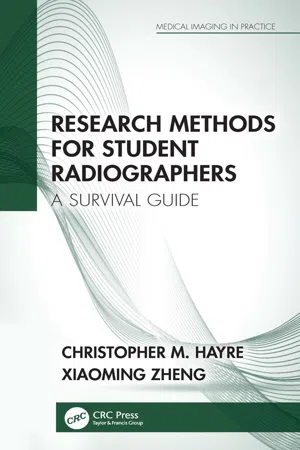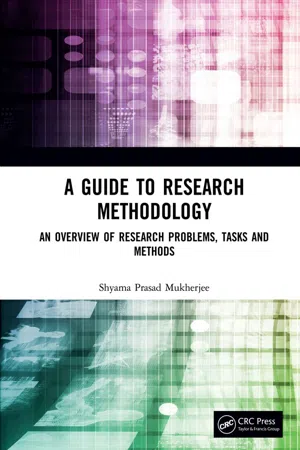Physics
Data Collection
Data collection in physics refers to the process of gathering and recording information or measurements about a physical system or phenomenon. This data can be collected through various methods such as experiments, simulations, or observations. The accuracy and precision of the data collected are crucial for the validity of any subsequent analysis or conclusions.
Written by Perlego with AI-assistance
Related key terms
Related key terms
1 of 4
Related key terms
1 of 3
3 Key excerpts on "Data Collection"
- eBook - ePub
Research Methods for Student Radiographers
A Survival Guide
- Christopher M. Hayre, Xiaoming Zheng(Authors)
- 2021(Publication Date)
- CRC Press(Publisher)
6Data Collection in Quantitative Research
Xiaoming ZhengDOI: 10.1201/9780367559311-66.1 IntroductionThis chapter concerns Data Collection in quantitative research. Data is not knowledge but knowledge creation relies on accurate data. Measurement is central to Data Collection, which is a multi-step process. The collection of high-quality data is guided by scientific intuition and the use of state-of-the-art or the highest quality instruments. Data Collection procedures stipulated in randomized controlled trials (RCT) are a gold standard for clinical investigations. Procedures less stringent than RCT procedures can be considered as quasi-experimental or pilot studies. Questionnaire surveys are a popular non-experimental Data Collection approach and we have used this method for various radiologic studies. The key to survey studies is the construct of questionnaire items that capture the principal components of the research question. Imaging information systems such as a picture archive and communication system (PACS) and publicly available clinical and imaging databases can be valuable sources of non-experimental data. We have used these databases for various studies, including derivations of various governing equations for optimal selections of imaging parameters in X-ray imaging. Published literature or unpublished data are collected for systematic review studies. Scientific knowledge should be generalizable and knowledge claims must be validated with high confidence.6.2 Measurement ProcessScientific measurement is at the centre of quantitative research. It assigns numbers to a system’s variables or elements of the phenomenon under study. For example, we use ionizing chambers to measure CT radiation doses and assign a number to the measured quantity (amount) of the dose. For this simple measurement, we need an instrument (ionizing chamber), the element or variable which is the dose, a scale and unit, which is a ratio scale in milligray. Other measurements, such as measuring diagnostic image quality, are not that straightforward. First, diagnostic image quality (element or dependent variable) itself is not well defined. It is clinical task (outcome) dependent. The instrument is the human observer who reads the images. We need a scale to quantize the image quality, such as a Likert scale used in education research (Cohen, Manion and Morrison, 2007 ). The Likert scale is different from the ratio scale used in radiation dose (mGy) measurement (Kothari, 2004 - eBook - ePub
A Guide to Research Methodology
An Overview of Research Problems, Tasks and Methods
- Shyama Prasad Mukherjee(Author)
- 2019(Publication Date)
- CRC Press(Publisher)
4Collection of Data
4.1 IntroductionIn this chapter, we would like to focus on the need for data in any research, be it theoretical or empirical, primarily involving qualitative analysis using nominal or categorical data and applying simple tools of logical reasoning or quantitative analysis with its usual emphasis on statistical concepts, methods, techniques and software. This is followed by a brief discussion of the two primary Data Collection mechanisms, viz. sample surveys and designed experiments. Instruments to be used in these two mechanisms to collect/generate primary data have been also indicated.Data have to be collected in any empirical research as the basic inputs. Both primary and secondary may be needed in some research, while only the former may be required in some other, while some research activity may deal only with analysis and interpretation of secondary data only. Secondary data have to be collected from their respective sources, due care being taken about their relevance, adequacy for the research objective(s), accuracy, reference to the time period of interest, operational definitions of terms and phrases used and the method of Data Collection and validation, etc. Sometimes similar data from different sources may have to be pooled with necessary care.Data Collection mechanisms following decisions on type, volume and quality of data as indicated in the research design play a very important role in all empirical researches. We generate numerical data when we measure or count some characteristic or feature possessed by the units or individuals selected for the study. (It should be remembered that most often – if not necessarily always – these selected units or individuals constitute a representative sample from the population or aggregate of units or individuals in which we are interested.) On the other hand, data by way of opinions or aptitude or attitude and also those related to purely observable attributes like language, complexion, religion, social group, occupation, etc. are ‘categorical’, in the sense that the responses derived from the respondents by direct observation or in terms of the responses to questions or other stimuli can be put into several categories. The number of categories should be neither too small to put all respondents in one category or a very few categories, nor too large to find very few responses in quite a few categories. In some cases, there may exist a natural number while in some others no such numbers pre-exist. Even in the case of a number pre-existing, we may group them into a smaller number. All this depends on the context. - eBook - ePub
- Graham Birley, Neil Moreland(Authors)
- 2014(Publication Date)
- Routledge(Publisher)
4Data CollectionThe data collecting part of a project is where many researchers feel the ‘real’ research occurs. Data collecting can be addictive, and can seriously endanger the health of the researcher and the completion of the research! Nonetheless the ‘fieldwork’ is where new information is acquired and its significance begins to be assessed.Data Collection is not just a process of collection, it is also a process of creation – of using information in unique ways related to the purposes of the study. There is a wide variety of data collecting methods available to researchers in the social sciences; deciding which to use will depend on:■ the particular methodology that has been selected (objectivist or constructivist, quantitative or qualitative (or mixtures of both)■ what is feasible in a given research situation■ what is likely to yield the most appropriate information.All these items are decided upon in the context of the particular research problem. Some of the more important data collecting methods are listed below.■ Questionnaires■ Interviews■ Documents■ Observations■ Accounts and protocols■ Dialogue records■ Tests■ Diaries and field notes■ Sociometry■ Focus groups■ Action research■ Repertory grid methods■ Attitude Scales■ Evaluation research■ Written and other works of various kinds (eg books, essays, computer assignments).Many of these data collecting methods have alternative forms. Observations, for instance, may be participant or non-participant, while interviews may be structured, semi-structured or unstructured. Despite this variety there are some basic principles which apply to all data collecting methods.BASIC PRINCIPLES OF Data CollectionFirst, any method must produce data that is relevant to the research question(s), and able to provide answers or illumination on the topic. Second, the technique must be convenient and relatively easy to use in the circumstances, for the researcher has to be sure that the expenditure of time (and resources) is warranted by the project. Perhaps most important, however, are issues of validity and reliability of the research techniques used.
Index pages curate the most relevant extracts from our library of academic textbooks. They’ve been created using an in-house natural language model (NLM), each adding context and meaning to key research topics.
Explore more topic indexes
Explore more topic indexes
1 of 6
Explore more topic indexes
1 of 4


